香港金融管理局电子银行监管手册
中国香港的中央银行制度

中国香港的中央银行制度
中国香港的中央银行是香港特别行政区的货币当局,负责制定和执行货币政策,发行货币,并维护香港的货币稳定。
以下是关于中国香港中央银行制度的主要特点:
香港金融管理局(HKMA):香港的中央银行实际上是香港金融管理局,简称HKMA。
HKMA是香港特别行政区的一个政府部门,于1993年成立。
货币发行:HKMA负责发行和管理香港的货币,包括香港元。
香港的货币政策主要以与美元的货币连系制度为基础,确保香港元的稳定性。
汇率制度:香港的货币与美元挂钩,即港元与美元的固定汇率关系。
这种制度有助于保持货币的稳定和国际信誉。
货币政策:HKMA通过货币政策来维护香港的货币和金融稳定。
该机构定期进行利率决策,以影响货币供应和需求。
金融监管:除了货币发行和政策制定外,HKMA还担任金融监管机构,监督香港金融机构,确保其合规运营。
国际金融中心:作为国际金融中心之一,香港的中央银行制度在维护货币和金融稳定的同时,还促进了香港作为全球金融枢纽的地位。
总体而言,香港的中央银行制度是与美元挂钩的货币连系制度,并由香港金融管理局负责执行货币政策、发行货币、进行金融监管等职责。
香港非银行业金融机构内控管理措施

设立详细书面合规手册、政策及程序及向全部员工提供,并予以检讨和依从。
身为持牌人士的员工须出席持续专业培训。
核心业务通过特别设计的系统经营,并维持足够的审核汇总程序。
本集团利用独立、声誉良好及可信的托管银行保障客户资产。
所有申购/赎回款项直接向/自托管银行支付。
进行客户识别及防治洗黑钱及恐怖分子融资程序,以核实身份及资金来源。
公司按照监管要求建立健全了信息隔离墙、未公开信息知情人登记、内幕信息知情人登记管理等制度并落实执行,有效防范了敏感信息的不当使用和传播。同时,公司严格按照法律、法规和公司《章程》的规定,真实、准确、完整、及时地披露信息,确保所有投资者均有平等的机会及时获得公司信息。
公司名称:惠理集团有限公司
公司性质:基金类
上市地:H股
公司治理架构:
董事会下设委员会:审核委员会、薪酬委员会、提名委员会、风险管理委员会。
内部控制情况:
内部监控的主要程序:
本集团内部监控制度组织架构设有明确汇报流程并将监督及报告的责任授予具有资格的经验人士。
每年制定业务计划及预算,由高级管理团队审阅及批准。
以行之有效的授权参数管理业务决策。
本公司将根据内部控制评价结果,对发现的内部控制缺陷进行持续整改,定期跟进措施评估。
本公司根据相关法律法规的要求,对公司2015年度的内部控制情况在控制环境、风险识别和评估、控制活动、信息与沟通、监督方面进行了自我评价,内部控制评估小组全面复核后得出评价结果。评价结果表明公司建立和加强了内部控制组织结构,不断完善风险管理体系,优化业务控制流程,改进资讯系统控制,强化内控管理和监督,从组织、人员、制度、流程和执行等方面确保公司内部控制目标的实现,并根据外部政策变化不断建立和加强内控体系。内控机制基本健全、合理,并得到有效执行,公司内部控制体系运行情况良好,为公司经营管理目标的实现提供了合理的保证,未发现存在重大缺陷。
初探香港银行卡收单业务监管
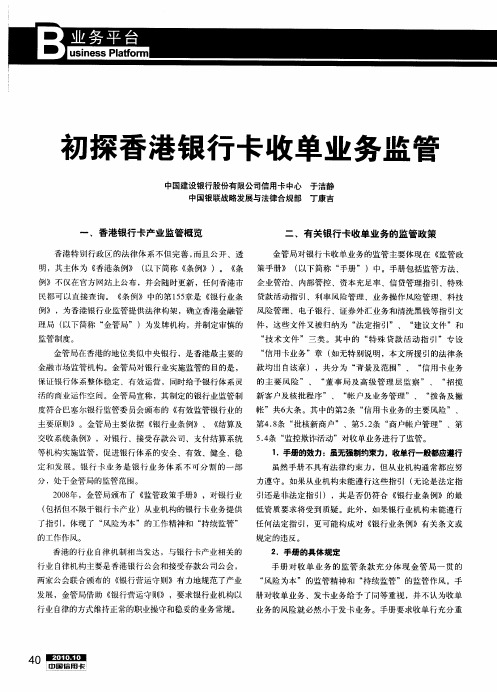
20 年 ,金管 局颁布 了 ( 08 ( 监管政 策手 册 ,对银 行业 引还 是非 法定 指 引 ),其是 否仍 符合 银行 业条 例 的最 ( 包括但 不限于银 行卡 产业 )从业 机构 的银行 卡业 务提供 低资 质要 求将 受到 质疑 。此 外 ,如果银 行业 机构 未 有限公 司信用 卡0, 于洁静 6 中国银联 战略发展 与法律 合规部 丁康吉
一
、
香港银行卡产业监管概 览
二 、有关银行卡收单业务的监管政策
金 管局 对银 行卡收 单业 务 的监 管主 要体 现在 监 管政
香 港特 别 行政 区 的法 律体 系 不但 完 善 , 且 公开 、透 而
的主 要 风 险 ” 、 “ 事 局 及 高 级 管 理 层监 察 ” 、 “ 董 招揽
活的商 业运作 空 间。金管 局宣称 ,其 制定 的银行业 监管 制 新 客 户及核 批程 序” 、 “ 户 及业务 管理 ” 、 “ 备及 撇 帐 拨
度符合 巴塞尔 银行监 管委 员会颁 布的 ( ( 监管银 行业 的 帐 ”共6 条 。其 中的第2 “ 用卡 业务 的主要 风 险” 、 有效 大 条 信 主 要原 则》 。金管局 主要 依据 银行业 条例 、 结算 及 第4 8 “ .条 批核 新商 户 ”、第 52 “ 户帐 户管理 ” 、第 .条 商 交 收系统 条例 ,对 银行 、接受 存款 公司 、支付结 算 系统 54 “ 控欺 诈活动 ”对收单业 务进行 了监管 。 .条 监 等 机构 实施监 管 ,促 进银行 体 系的安全 、有 效 、健 全 、稳
2 .手 册的具体 规定
手册 对 收 单 业 务 的监 管 条 款 充 分 体 现 金 管 局 一 贯 的 “ 险为本 ” 的监管 精神 和 “ 风 持续监 管 ”的监 管 作风 。手
香港黄金交易市场的交易监管如何执行

香港黄金交易市场的交易监管如何执行香港作为全球重要的金融中心之一,其黄金交易市场在国际金融领域占据着重要地位。
为了保障市场的公平、公正、透明和稳定,香港实施了一系列严格而有效的交易监管措施。
首先,香港金融管理局(简称金管局)在交易监管中发挥着关键作用。
金管局负责制定和执行相关的金融政策,确保黄金交易市场的稳健运行。
它对参与黄金交易的金融机构进行严格的监管,包括银行、证券公司等。
这些金融机构需要满足一系列的资本充足率、风险管理和内部控制等要求。
金管局会定期对它们进行检查和评估,以确保其合规运营。
在法律框架方面,香港拥有完善的金融法规体系。
《证券及期货条例》等相关法律为黄金交易提供了明确的法律规范。
这些法律涵盖了交易行为、市场操纵、内幕交易等多个方面。
对于违反法律法规的行为,制定了严厉的处罚措施,包括高额罚款、监禁甚至吊销从业资格等,从而对潜在的违法违规行为起到强大的威慑作用。
在市场准入方面,香港对黄金交易商和经纪商设定了严格的准入标准。
申请者需要具备一定的资金实力、良好的信誉记录和专业的管理团队。
此外,还需要通过严格的审批程序,包括对其业务模式、风险管理能力和合规制度的审查。
只有获得相关牌照和许可的机构,才能在香港从事黄金交易业务。
为了确保交易的透明度,香港要求黄金交易参与者必须及时、准确地披露相关信息。
这包括交易价格、成交量、交易对手等重要信息。
同时,交易所还会对交易数据进行监控和分析,以便及时发现异常交易行为和潜在的市场风险。
香港的黄金交易市场还注重对投资者的保护。
金融监管机构会通过各种渠道向投资者普及金融知识和风险教育,帮助他们了解黄金交易的特点和风险。
此外,还设立了投资者赔偿基金,为在合法交易中遭受损失的投资者提供一定程度的赔偿。
在交易结算和清算方面,香港采用了先进的系统和制度。
确保交易的款项和黄金交割能够及时、准确地完成,减少交易风险和纠纷。
同时,清算所还承担着风险管理的职责,对会员的交易头寸进行监控和风险评估。
内地与香港银行合规监管的差异与合作

内地与香港银行合规监管的差异与合作
内地与香港的银行合规监管存在一些差异,但也开展了一定的合作。
以下是它们的主要差异和合作方面:
1. 差异:
- 法律体系:内地银行合规监管受到中国法律体系的制约,而香港则有独立的法律体系。
- 监管机构:内地的银行合规监管主要由中国银行业监督管理委员会(简称“银监会”)负责,而香港由香港金融管理局(简称“金管局”)负责。
- 监管标准:内地的监管标准相对更严格,因为内地金融风险更为敏感,而香港更注重市场化和国际接轨。
- 控制措施:内地银行合规监管更强调管理和控制措施,而香港则更注重市场自律和信息披露。
2. 合作:
- 信息共享:内地与香港的监管机构会进行信息的共享和交流,以便更好地监管跨境金融活动。
- 金融合作:内地与香港在金融方面有许多合作机制,如互联互通机制、债券市场互联互通等,这也需要对合规进行合作监管。
- 培训交流:监管机构之间定期进行培训和交流,以提高监管人员的专业水平和合规意识。
总体来说,内地与香港的银行合规监管存在一些差异,但也都致力于保护金融体系的稳定和健康发展,通过合作与交流来提高银行的合规水平。
监管政策手册
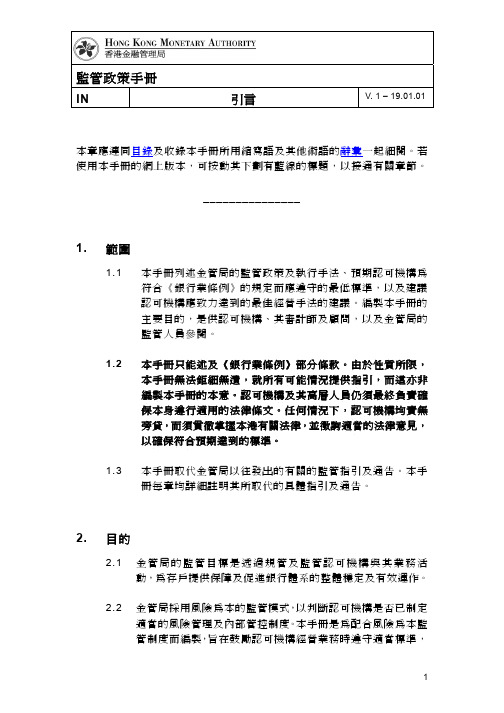
監管政策手冊IN引言V. 1 – 19.01.01本章應連同目錄及收錄本手冊所用縮寫語及其他術語的辭彙㆒起細閱。
若使用本手冊的網㆖版本,可按動其㆘劃有藍線的標題,以接通有關章節。
_______________1. 範圍1.1 本手冊列述金管局的監管政策及執行手法、預期認可機構為符合《銀行業條例》的規定而應遵守的最低標準,以及建議認可機構應致力達到的最佳經營手法的建議。
編製本手冊的主要目的,是供認可機構、其審計師及顧問,以及金管局的監管㆟員參閱。
1.2 本手冊只能述及《銀行業條例》部分條款。
由於性質所限,本手冊無法鉅細無遺,就所有可能情況提供指引,而這亦非編製本手冊的本意。
認可機構及其高層㆟員仍須最終負責確保本身遵行適用的法律條文。
任何情況㆘,認可機構均責無旁貸,而須貫徹掌握本港有關法律,並徵詢適當的法律意見,以確保符合預期達到的標準。
1.3 本手冊取代金管局以往發出的有關的監管指引及通告。
本手冊每章均詳細註明其所取代的具體指引及通告。
2. 目的2.1 金管局的監管目標是透過規管及監管認可機構與其業務活動,為存戶提供保障及促進銀行體系的整體穩定及有效運作。
2.2 金管局採用風險為本的監管模式,以判斷認可機構是否已制定適當的風險管理及內部管控制度。
本手冊是為配合風險為本監管制度而編製,旨在鼓勵認可機構經營業務時遵守適當標準,監管政策手冊IN引言V. 1 – 19.01.01並採取審慎的風險管理經營手法,以能符合穩健及安全的經營之道。
具體來說,本手冊:•闡明金管局如何詮釋認可機構在《銀行業條例》㆘的責任;•建議認可機構在履行責任時應執行的當前最佳的手法;•釐定金管局預期認可機構應達到的最低審慎標準。
2.3 金管局規定所有認可機構須遵守本手冊所載的最低標準,並鼓勵它們按照本身業務需要致力達到最佳經營手法。
認可機構管理層的首要責任,是確保認可機構適當遵守這些標準及執行手法,以管理認可機構的業務風險、保障資產,以及遵守《銀行業條例》及其他適當法律。
第五章 香港的金融监管

充足标准,保持不少于8%的法定资本充足率。 4.CAMEL评级制度 CAMEL评级制度是一套国际公认的制度。这套评级制度包 括五个基本项目,即:资本充足率(Capital Adequacy); 资产质量(Assets quality);管理能力(Management);盈 利性(Earning);流动性(Liquidity)。通过以上五个方面 评价以衡量金融机构的资信等级。由于这五个项目的第一 个字母组成CAMEL一词,因此,也被叫做“骆驼评级制度”。 香港金管局在1995年正式引入这个评级制度。
图1 :香港的金融监管框架图
资料来源:香港监管局等网站
(二)香港金管局 香港金管局成立于1994年4月,金管局根据《银行业条 例》的授权,对持牌银行、有限制持牌银行和接受存款公 司实行审慎监管。其监管方法有现场审查和非现场审查。 除了监管银行业外,金管局的其它功能和目标包括维持港 元稳定、提高金融制度的效率及促进其发展,以及维护廉 洁公正的金融制度,这与世界各地中央银行的功能和目标 大致相同。在1993年,政府把外汇基金办事处及银行业监 理处合并为金管局,主要目的是确保维持金融体制及银行 业稳定等中央银行的功能,能够由一个具专业知识的机构 执行,并保持政策的延续性,从而维系港人及国际财经界 对香港的信心。
(4)盈利性。以税后净收益与总资产之比衡量,并根据金 融机构资产规模大小加以区别。例如,小于1亿美元总资 产的银行,此比例达到1.15%以上为1等,达到0.95%为2 等,达到O.75%为3等,小于0.75%为4等,净亏损则为5 等 (5)流动性。主要观察短期投资、主要存款、贷款与租赁、 变动债务等与总资产的比例。
第二节 各行业的监管
(一)银行业监管 1.法律基础 《银行业条例》是香港银行业监管的法律基础。 2.监管制度 建立符合国际标准的银行监管制度,特别是巴塞尔银行 监督管理委员会建议的制度。 3.监管目标 通过规定银行业务和接受存款业务,以及监管机构认可 机构,促进银行体系的安全和稳定。所有本地注册认可机 构均须按照巴塞尔委员会1988年《本协议》所订明的资本
香港金融管理局《监管政策手册》
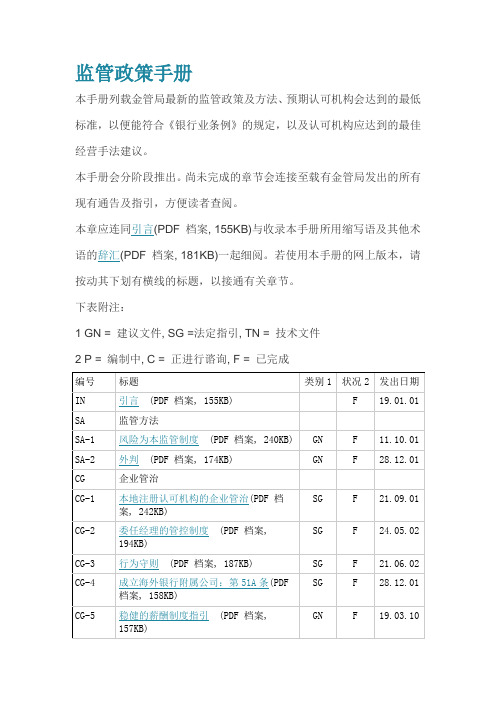
监管政策手册
本手册列载金管局最新的监管政策及方法、预期认可机构会达到的最低标准,以便能符合《银行业条例》的规定,以及认可机构应达到的最佳经营手法建议。
本手册会分阶段推出。
尚未完成的章节会连接至载有金管局发出的所有现有通告及指引,方便读者查阅。
本章应连同引言(PDF 档案, 155KB)与收录本手册所用缩写语及其他术语的辞汇(PDF 档案, 181KB)一起细阅。
若使用本手册的网上版本,请按动其下划有横线的标题,以接通有关章节。
下表附注:
1 GN = 建议文件, SG =法定指引, TN = 技术文件
2 P = 编制中, C = 正进行谘询, F = 已完成。
商业银行非现场监管流程
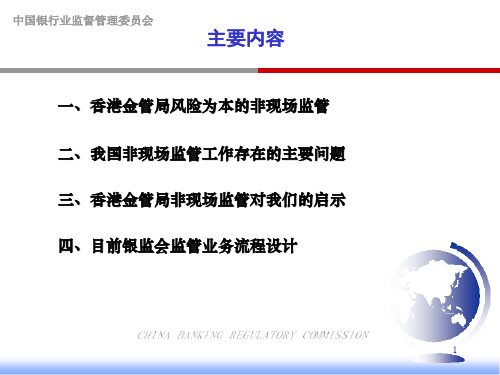
中国银行业监督管理委员会
(二)香港金管局风险为本的非现场监管
6、金管局非现场监管与现场检查的关系。 个案主任对金融机构进行连续不断的非现场监管, 一旦发现其业务有不寻常的变化情况或风险状况有所提 高,他可以建议对其进行现场检查,并在获得有关高级 经理同意后,将相关分析转交负责现场检查的人员。现 场检查人员会就个案主任的分析到该金融机构进行现场 检查。检查重点在于查阅金融机构的内部档案、检查相 关操作程序的可靠性、审查内控能力及与相关负责人详 细讨论具体风险。之后现场检查人员会把检查结果通知 个案主任,从而达到持续监管的目的。
2
中国银行业监督管理委员会
(一)非现场监管的概念和作用
1、非现场监管的概念。 非现场监管又称“非现场监测”、“非现场监控”,是 按照审慎监管原则进行银行监管活动的重要方式之一。具体 而言,非现场监管是指监管机构通过收集有关金融机构经营 管理相关数据材料,运用一定的技术方法(如各种模型与比 例分析等),研究分析金融机构经营的总体状况、风险管理 状况以及合规情况等,发现其风险管理中存在的问题,并对 其稳健性进行评价。监管部门通过非现场监管,能够及时、 持续监测金融机构的经营和风险状况,并能为现场检查提供 依据和指导,使现场检查更有针对性,从而有利于合理分配 监管资源,发挥现场检查的最大效力。
22
中国银行业监督管理委员会
(二)香港金管局风险为本的非现场监管
4、金管局非现场监管的主要工作流程。
市场信息
年报、 半年报
1
6
2
定期报表
5
3
4
例外报告
调查表
23
中国银行业监督管理委员会
(二)香港金管局风险为本的非现场监管
4、金管局非现场监管的主要工作流程。 (1)非现场监管报表的制定与修改
“数字外管”平台银行版功能与用户操作手册20190819

“数字外管”平台银行版功能与用户操作手册一、“数字外管”平台建设内容按照分类、整合、优化思路,构建“数字外管”平台银行版,重构外汇业务应用功能布局。
一是按照数据申报、业务办理、数据查询、业务监测、统计报表、系统管理、留言公告、我的业务等分类,对原应用功能进行重构;二是整合银行版企业档案维护、公共代码查询等类似功能,解决多头维护不一致问题;三是清理已停用功能(如个人、直接投资等升级替代的系统功能)。
(一)重构应用功能布局“数字外管”平台依据业务操作员的日常业务操作类型,将功能具体划分为数据申报、业务办理、数据查询、业务监测、统计报表、系统管理、留言公告等。
在每个分类下,对外汇业务进行功能菜单的组织与合并,减少菜单层级,方便业务人员使用。
同时,“数字外管”平台还提供了“我的业务”,满足每个业务人员的个性化业务需求,可在自己账户最大权限范围内,进行功能展示的自定义设置。
此外,还提供收藏等功能,方便银行业务人员使用,提升友好性。
为顺利过渡,“数字外管”平台的权限角色保持与现有各系统的角色相对应,并在原系统角色基础上根据业务操作类型进行细化,将角色细分至数据申报、业务办理、数据查询等类型角色。
银行现有用户及功能角色由外汇局统一迁移到“数字外管”平台银行版。
对于新增用户,银行业务管理员(ba)应使用“业务操作员(新)”功能(具体操作见第三部分)为其用户分配“数字外管”平台有关功能角色。
(二)统一银行端企业档案维护功能现有企业档案维护功能分散在各业务应用中且存在多头维护现象,导致数据一致性存在问题。
本次“数字外管”平台银行端上线一个重要工作就是将分散在原国收、账户、资本业务应用中的企业档案维护功能进行整合,实现银行端企业主体档案统一采集与维护,明确数据项维护的逻辑关系,解决银行多头维护企业主体,且存在部分要素不一致的现状。
银行将使用新增的“主体档案维护功能”(新增、修改、查询)替代上述三个系统的企业档案维护功能。
中央银行学作业:香港准中央银行制度

返回
汇丰银行
香港上海汇丰银行有限公司(The Hongkong and Shanghai Banking Corporation Limited, 中文直译为“香港和上海银行有限 公司”,英文缩写HSBC,中文简 称汇丰,取“汇款丰裕”之意)为 汇丰控股有限公司的全资附属公司, 属于汇丰集团的创始成员以及在亚 太地区的旗舰,也是香港最大的注 册银行,以及香港三大发钞银行之 一(其他两个是中国银行(香港) 和渣打银行),总部位于中环皇后 大道中1号香港汇丰总行大厦,现 时香港上海汇丰银行及各附属公司 主要在亚太地区设立约700间分行 及办事处。
渣打银行
渣打银行香港有限公司:标准渣打银行自1859年起便 在香港开展业务至今。时至今日,香港地区已成为 渣打银行的主要市场。香港是渣打最大的市场,早 于1859年,渣打银行已经开始在香港开展业务;标 准渣打银行1862年开始发行港元钞票。现时为香港 银行公会3间主席银行之一。 1987年,旧渣打香港 总部拆卸(但1988年至1992年间发行的渣打银行钞 票还有旧渣打香港总部的图案),而新厦渣打银行 大厦于1990年春季建成。
渣打银行
(又称标准渣打银行、标准银行;英语:Standard Chartered Bank;LSE:STAN,港交所:2888, OTCBB:SCBFF)是一家总部在伦敦的英国银行。 它的业务遍及许多国家,尤其是在亚洲和非洲,在 英国的客户却非常少,2004年其利润的30%来自于 香港地区。渣打银行的母公司渣打集团有限公司则 于伦敦证券交易所及香港交易所上市,亦是伦敦金 融时报100指数成份股之一。2012年8月14日,被 指控协助伊朗进行违规转账交易的渣打银行与纽约 州达成3.4亿美元和解。
由于这个原因,2005年1月1日起不再发行钞票(香港上海汇丰银行有限公司 及中国银行(香港)钞票为止。
香港金融管理局的货币发行与银行监管

。
持
。
换言之
.
基 础 货 币 的任 何 变动 必 须
一
金 融 管 理 专 员 的办 公 室
金 融 管理 专 员
与 外 汇 储备 的相 应 变动
致
。
三
家发 钞
相 应 成 为金 管局 的 总 裁
。
所以
.
在香 港
根据 《 行业 条例》 香港 还 银
,
—
银 行分 别 为香 港 上 海 汇 丰银 行 有限 公
。
表
1
:
香 港 的认 可 存 款 机 构 构 成
23 12 1 14 12 27 O 64
133
行基 金 与 外 汇 基 金 合 并 政 府在 1 9 7 6 年
。
《 币 条例 》 (后 改 名 为 《 ; 基 金 条 货 外 E
) 例》 设 立
。
家 外 资 银行 的代 表处 表
2
1 是 香港 2 0 0 9
。
年
自成 立 以 来 基 金
,
一
直持有
月认 可 机 构 的构 成情 况 表 2 是 2 0 0 8 年
。
的银 行 监 管较 为 灵 活 位 的互 动
.
,
。
行 这 些 认 可 机 构 中 有 1 8 1 家 由来 自 2 9
。
.
银 否 有 需 要 修 订 《 行 业 条 例 》 (( 2 0 0 5 年
。
193 5
年的
个 国 家的机 构 拥 有
。
此外
。
,
香港还 有 7 1
银 行 业 (修 订 ) 条例 》为 在 香 港 推 行 新 巴 塞 尔协 议提 供 了 所 需 的 法 律 架 构 香 港
香港货币制度
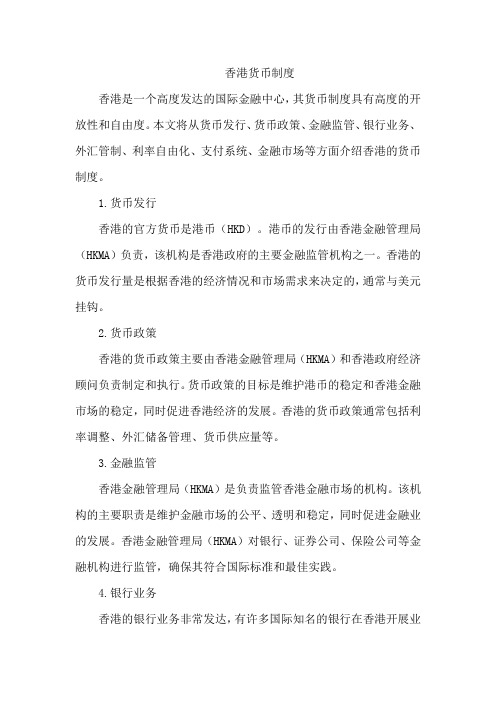
香港货币制度香港是一个高度发达的国际金融中心,其货币制度具有高度的开放性和自由度。
本文将从货币发行、货币政策、金融监管、银行业务、外汇管制、利率自由化、支付系统、金融市场等方面介绍香港的货币制度。
1.货币发行香港的官方货币是港币(HKD)。
港币的发行由香港金融管理局(HKMA)负责,该机构是香港政府的主要金融监管机构之一。
香港的货币发行量是根据香港的经济情况和市场需求来决定的,通常与美元挂钩。
2.货币政策香港的货币政策主要由香港金融管理局(HKMA)和香港政府经济顾问负责制定和执行。
货币政策的目标是维护港币的稳定和香港金融市场的稳定,同时促进香港经济的发展。
香港的货币政策通常包括利率调整、外汇储备管理、货币供应量等。
3.金融监管香港金融管理局(HKMA)是负责监管香港金融市场的机构。
该机构的主要职责是维护金融市场的公平、透明和稳定,同时促进金融业的发展。
香港金融管理局(HKMA)对银行、证券公司、保险公司等金融机构进行监管,确保其符合国际标准和最佳实践。
4.银行业务香港的银行业务非常发达,有许多国际知名的银行在香港开展业务。
香港的银行主要提供个人和企业贷款、存款、理财等服务。
同时,香港也是全球最大的离岸人民币中心之一,因此,许多银行也提供人民币业务。
5.外汇管制香港是一个开放的经济体,其外汇管制相对较少。
香港政府对贸易和投资项下的外汇管制较为宽松,但对资本流动有一定的限制。
具体来说,香港政府对资本流入实行自由化政策,但对资本流出实行较为严格的管制。
6.利率自由化香港是一个利率自由化的市场。
银行可以自由决定其存款和贷款利率,这使得市场竞争更加激烈。
因此,客户可以在不同的银行之间进行比较,选择最优惠的利率。
这种利率自由化的市场有助于提高银行的竞争力和服务质量。
7.支付系统香港的支付系统非常发达,有许多不同的支付方式可供选择。
例如,信用卡、借记卡、网上银行、手机银行等。
这些支付方式都提供了方便快捷的支付方式,同时也提高了资金的使用效率。
HKMA商业银行流动资金风险监管及启示
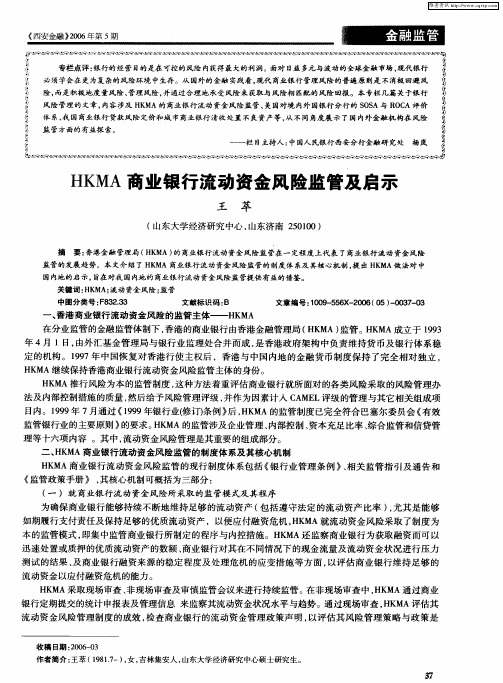
监 管的发展 趋势。本文介绍 了 HK A 商业银行 流动 资金 风险监管的制度体 系及其核 心机 制 , 出 HK M 提 MA做 法对 中 国内地的启示 , 旨在对我 国内地的商业银行流动资金 风险监 管提供 有益的借鉴 。 关键词 : K H MA; 流动资金 风险 ; 监管 中图分类号 : 8 23 F 3 .3
二、 K H MA商 业银 行流 动资 金风 险监 管 的制度 体 系及 其核心 机 制
H M K A商业银行流动资金风险监管 的现行制度体系包括 《 银行业管理条例 》 相关监管指引及通告 和 、
《 监管政 策 手册 》 , 其核 心 机制 可概 括为 三部 分 : ( )就 商业银 行 流动 资金 风 险所采 取 的监 管模 式及其 程序 一
收 稿 日期 :0 6 0 20— 3
作者简介 : 王萃 ( 9 1 一) 女 , 18 , 吉林集安人 , 7 山东大学经济研究 中心硕 士研究生 。
维普资讯
《 西安金融 》 0 6年第 5期 20
பைடு நூலகம்
否足 够 。
若商业银行未能符合法定的最低流动资产比率或履行到期支付责任 , 未有足够的流动资金 以应付危机
为确保商业银行能够持续不断地维持足够 的流动资产 ( 包括遵守法定 的流动资产 比率 )尤其是能够 ,
如期履行支付责任及保持足够的优质流动资产 ,以便应付融资危机 , K A就流动资金风险采取了制度为 H M
本的监管模式 , 即集 中监管商业银行所制定 的程序与内控措施 。H M K A还监察商业银行为获取融资而可以
H M K A采取现场审查 、 非现场审查及审慎监管会议来进行持续监管 。 在非现场审查 中, K A通过商业 HM
香港金融管理局监管政策手册 HKMA SPM-AML-1

(d) 《聯合國制裁條例》(第537章),大部分安理會決議 都是根據該條例在香港實施,並構成香港的金融制裁 制度的基礎。
(e) 《大規模毀滅武器(提供服務的管制)條例》(第526 章),尤其第4條,禁止某人在有合理理由相信或懷疑 提供的服務可能與大規模毀滅武器擴散有關的情況下 提供該等服務。
1
監管政策手冊
AML-1
打擊洗錢及恐怖分子金籌集 的監管方法
V.1 – 19.10.18
3. 金管局的打擊洗錢及恐怖分子資金籌集政策 3.1 打擊洗錢及恐怖分子資金籌集 3.2 遵守制裁措施
4. 認可機構及金管局在香港的打擊洗錢及恐怖分子資金籌集制度 中的角色
5. 監管方法 5.1 風險為本的監管 5.2 了解銀行業的洗錢及恐怖分子資金籌集風險 5.3 了解個別認可機構的洗錢及恐怖分子資金籌集風險 5.4 監管程序 5.5 監管及執法措施
1.1.3 在香港的整體打擊洗錢及恐怖分子資金籌集制度中,金管 局已制定適用於銀行業的有關政策及指引,以維護銀行體 系免受洗錢及恐怖分子資金籌集風險的影響。
1.2 應用
1.2.1 本單元列載金管局為管理洗錢及恐怖分子資金籌集風險而 對認可機構採取的以風險為本方法為基礎的整體政策與監 管方法。本單元應連同《香港洗錢及恐怖分子資金籌集風 險 評 估 報 告 》 1、 《 打擊洗錢及恐怖分子資金籌集指引(認可機 構適用)》(「 《打擊洗錢指引》」)及不時由金管局刊發的其他 有關打 擊 洗 錢 及 恐 怖 分 子 資 金 籌 集 的 指 引 一 併 閱 讀 。
3. 金管局的打擊洗錢及恐怖分子資金籌集政策
3.1 打擊洗錢及恐怖分子資金籌集
香港证券及期货从业资格考试-温习手册整理版-HK
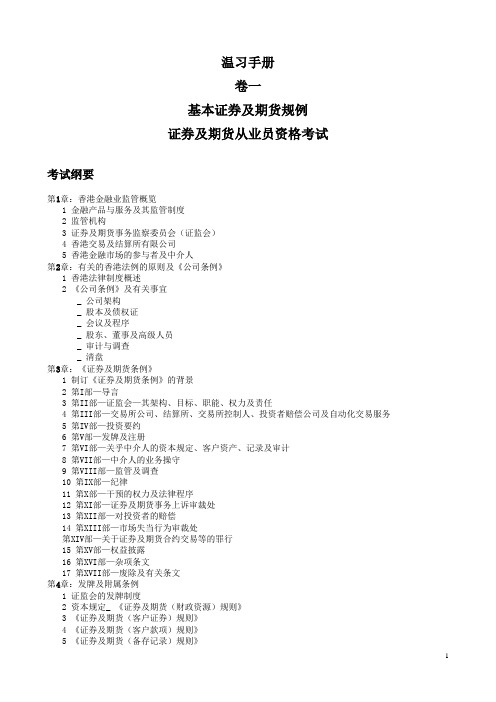
温习手册卷一基本证券及期货规例证券及期货从业员资格考试考试纲要第1章:香港金融业监管概览1 金融产品与服务及其监管制度2 监管机构3 证券及期货事务监察委员会(证监会)4 香港交易及结算所有限公司5 香港金融市场的参与者及中介人第2章:有关的香港法例的原则及《公司条例》1 香港法律制度概述2 《公司条例》及有关事宜_ 公司架构_ 股本及债权证_ 会议及程序_ 股东、董事及高级人员_ 审计与调查_ 清盘第3章:《证券及期货条例》1 制订《证券及期货条例》的背景2 第I部—导言3 第II部—证监会—其架构、目标、职能、权力及责任4 第III部—交易所公司、结算所、交易所控制人、投资者赔偿公司及自动化交易服务5 第IV部—投资要约6 第V部—发牌及注册7 第VI部—关乎中介人的资本规定、客户资产、记录及审计8 第VII部—中介人的业务操守9 第VIII部—监管及调查10 第IX部—纪律11 第X部—干预的权力及法律程序12 第XI部—证券及期货事务上诉审裁处13 第XII部—对投资者的赔偿14 第XIII部—市场失当行为审裁处第XIV部—关于证券及期货合约交易等的罪行15 第XV部—权益披露16 第XVI部—杂项条文17 第XVII部—废除及有关条文第4章:发牌及附属条例1 证监会的发牌制度2 资本规定_ 《证券及期货(财政资源)规则》3 《证券及期货(客户证券)规则》4 《证券及期货(客户款项)规则》5 《证券及期货(备存记录)规则》6 《证券及期货(成交单据、户口结单及收据)规则》7 《证券及期货(帐目及审计)规则》第5章:业务操守及客户关系1 证监会持牌人或注册人操守准则2 基金经理操守准则3 企业融资顾问操守准则4 股份登记机构操守准则第6章:业务运作及实务1 适用于证监会的注册人和持牌人的管理、监督及内部监控指引2 洗黑钱及恐怖分子筹资活动_ 证监会就防止洗黑钱及恐怖分子筹资活动发出的指引3 互联网交易及顾问服务4 自动化交易服务5 除《证券及期货条例》以外的卖空规定6 未获缴约的造访_ 证券及期货(未获邀约的造访—豁免)规则7 中介人的承保范围_ 证券及期货(保险)规则第7章:证券、期权及期货1 证券交易_ 香港联合交易所有限公司(联交所)业务_ 证券保证金融资2 在联交所买卖的期权3 在香港期货交易所进行的期货合约买卖4 就证券及期货合约提供意见第8章:其它证监会规管活动1 机构融资及机构融资顾问_ 联交所颁布的上市规则_ 收购、合并及股份购回2 资产管理_ 根据《证券及期货条例》_ 根据《强制性公积金计划条例》3 杠杆式外汇交易第9章:市场失当行为、不当交易行为及遵守法则1 《证券及期货条例》所述的市场失当行为_ 《证券及期货条例》对市场失当行为的定义_ 内幕交易_ 虚假交易_ 操控价格_ 操纵证券市场_ 披露关于受禁交易的资料_ 披露虚假或具误导性的资料_ 不构成市场失当行为的操守(安全港守则)_ 欺诈及欺骗2 不当交易行为3 投资者赔偿安排4 《个人资料(私隐)条例》5 遵守法规与有关问题_ 企业管治_ 高级管理层、董事及少数股东第1章:香港金融业监管概览目录本章概览1学习重点11 金融产品与服务及其监管制度3引言 3香港监管机构的宗旨 3过往的监管问题 52 监管机构6政府各级的角色 6香港的金融监管机关 83 证券及期货事务监察委员会12监管职能及架构 12董事会、委员会、审裁处及工作小组 14证监会营运部门的职能 16纪律处分权力、纪律行动、纪律处分程序及惩罚 18与政府、地方及境外监管机构及国际证券事务监察委员会组织的相互作用 194 香港交易及结算所有限公司215 香港金融市场的参与者及中介人22概要 25要点 25本章概览本章向读者概述香港金融服务业及其监管制度:●本章先简单介绍向投资者提供的产品及服务,以及必须实施监管的原因。
香港 银行 安全法规

香港银行安全法规
香港的银行安全法规主要包括以下方面:
1.《香港金融管理局》(Hong Kong Monetary Authority, HKMA)在香港担任银行监管机构的角色,负责制定和实施
监管政策和法规,以确保银行的安全稳健运营。
2.《反洗钱及恐怖分子资金筹集防制条例》(Anti-Money Laundering and Counter-Terrorist Financing Ordinance,
AML/CFT Ordinance)要求银行建立有效的反洗钱和反恐怖融
资制度,进行客户尽职调查,监测可疑交易,报告可疑交易。
3.《数据保护条例》(Personal Data (Privacy) Ordinance)规定
了银行如何保护客户的个人数据,限制个人数据的使用和披露,并确保数据安全。
4.《金融机构(有限责任)条例》(Banking Ordinance)设立
了香港金融管理局,并规定了银行的注册要求、资本充足要求、监管政策等。
5.《电子交易安全条例》(Electronic Transactions Ordinance)
规定了银行在进行电子交易时必须采取的安全措施,保护客户的交易安全和个人信息保密。
此外,香港的银行还需要遵守国际金融合规标准,如国际货币基金组织(IMF)的《金融行动特别任务部队(FATF)40条
推荐和9项特别推荐措施》,以及国际标准组织(ISO)的信息安全管理体系标准(ISO 27001)等。
香港的金融制度
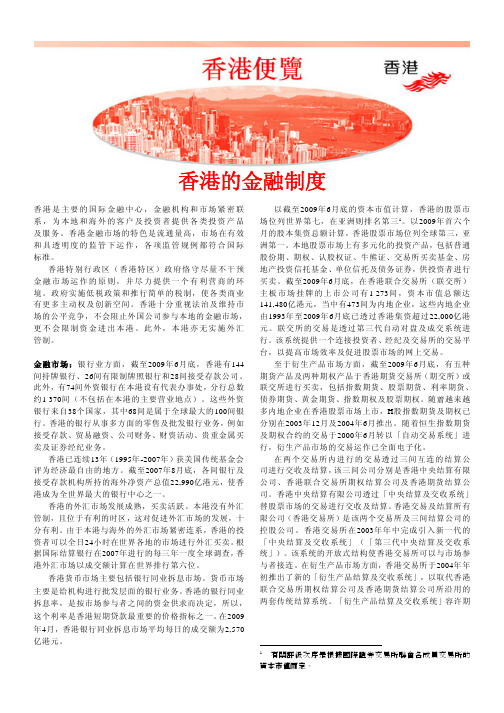
香港的金融制度香港是主要的国际金融中心,金融机构和市场紧密联系,为本地和海外的客户及投资者提供各类投资产品及服务。
香港金融市场的特色是流通量高,市场在有效和具透明度的监管下运作,各项监管规例都符合国际标准。
香港特别行政区(香港特区)政府恪守尽量不干预金融市场运作的原则,并尽力提供一个有利营商的环境。
政府实施低税政策和推行简单的税制,使各类商业有更多主动权及创新空间。
香港十分重视法治及维持巿场的公平竞争,不会阻止外国公司参与本地的金融市场,更不会限制资金进出本港。
此外,本港亦无实施外汇管制。
金融市场:银行业方面,截至2009年6月底,香港有144间持牌银行、26间有限制牌照银行和28间接受存款公司。
此外,有74间外资银行在本港设有代表办事处,分行总数约1 370间(不包括在本港的主要营业地点)。
这些外资银行来自38个国家,其中68间是属于全球最大的100间银行。
香港的银行从事多方面的零售及批发银行业务,例如接受存款、贸易融资、公司财务、财资活动、贵重金属买卖及证券经纪业务。
香港已连续13年(1995年-2007年)获美国传统基金会评为经济最自由的地方。
截至2007年8月底,各间银行及接受存款机构所持的海外净资产总值22,990亿港元,使香港成为全世界最大的银行中心之一。
香港的外汇市场发展成熟,买卖活跃。
本港没有外汇管制,且位于有利的时区,这对促进外汇市场的发展,十分有利。
由于本港与海外的外汇市场紧密连系,香港的投资者可以全日24小时在世界各地的市场进行外汇买卖。
根据国际结算银行在2007年进行的每三年一度全球调查,香港外汇市场以成交额计算在世界排行第六位。
香港货币市场主要包括银行同业拆息市场。
货币市场主要是给机构进行批发层面的银行业务。
香港的银行同业拆息率,是按市场参与者之间的资金供求而决定,所以,这个利率是香港短期贷款最重要的价格指标之一。
在2009年4月,香港银行同业拆息市场平均每日的成交额为2,570亿港元。
2021年金融市场基础知识单选题与答案解析(12)
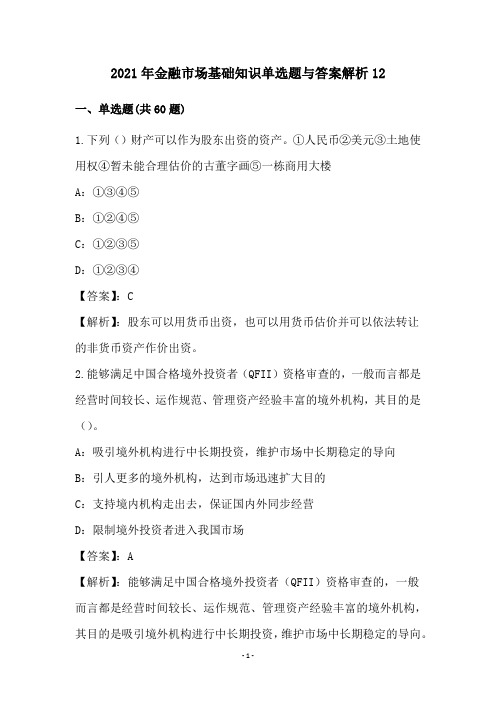
2021年金融市场基础知识单选题与答案解析12一、单选题(共60题)1.下列()财产可以作为股东出资的资产。
①人民币②美元③土地使用权④暂未能合理估价的古董字画⑤一栋商用大楼A:①③④⑤B:①②④⑤C:①②③⑤D:①②③④【答案】:C【解析】:股东可以用货币出资,也可以用货币估价并可以依法转让的非货币资产作价出资。
2.能够满足中国合格境外投资者(QFII)资格审查的,一般而言都是经营时间较长、运作规范、管理资产经验丰富的境外机构,其目的是()。
A:吸引境外机构进行中长期投资,维护市场中长期稳定的导向B:引人更多的境外机构,达到市场迅速扩大目的C:支持境内机构走出去,保证国内外同步经营D:限制境外投资者进入我国市场【答案】:A【解析】:能够满足中国合格境外投资者(QFII)资格审查的,一般而言都是经营时间较长、运作规范、管理资产经验丰富的境外机构,其目的是吸引境外机构进行中长期投资,维护市场中长期稳定的导向。
3.以下对实体经济与金融之间的相互关系的表述中,不完全合理的是()。
A:实体经济发展水平和质量从根本上决定着金融发展水平和质量,实体经济发展不好,风险最后会集中反映在金融体系中B:金融的健康发展可以促进经济增长C:金融产品的创新和复杂化,使得实体经济和金融的界限日益分明D:金融监管可以避免金融与实体经济发展的过分脱节【答案】:C【解析】:实体经济和金融之间相辅相成、相互渗透,实体经济是根,金融是滋养实体经济的水分。
实体经济发展水平和质量从根本上决定着金融发展水平和质量,实体经济发展不好,风险最后会集中反映在金融体系中,金融的健康发展可以促进经济增长,反之则不利于经济增长。
金融产品的创新和复杂化,使得实体经济和金融的界限日益模糊,所以A、B正确,C不正确,为保证经济的平稳运行和可持续发展,需要处理好金融发展和金融监管的关系,金融监管可以避免金融与实体经济发展的过分脱节。
4.所交易金融资产到期期限在1年以上或者没有到期期限的金融市场,是()。
香港金管局制度

香港金管局制度香港金管局(The Hong Kong Monetary Authority,简称HKMA)是香港特别行政区的金融管理机构,负责监管和维护香港金融体系的稳定与发展。
其主要职责包括货币发行、银行监管、外汇管理以及金融稳定监测等。
首先,香港金管局负责货币发行和外汇管理。
作为香港特别行政区的中央银行,金管局负责维持港元的稳定,确保市场对港币的信心。
它通过实施货币政策、调整利率、参与外汇市场操作等手段,稳定市场并避免通货膨胀或通缩的发生。
其次,金管局的另一个重要职责是银行监管。
它负责确保香港银行和其他金融机构的稳定运营,并保护市场的健康发展。
金管局拥有广泛的监管权力,包括制定和实施监管政策、批准银行牌照、监督银行风险管理和资本充足性、审计金融机构的业务以及处理金融机构的破产等。
此外,金管局还扮演着金融稳定监测的角色。
它负责监测和评估香港金融体系的稳定性,包括监测金融体系的流动性、资产负债表风险以及其他市场风险。
金管局还与其他国际金融机构和监管机构合作,分享信息和经验,以促进金融体系的跨国监管合作。
香港金管局的制度也制定了一系列规范,以确保其工作的独立性和高效性。
首先,金管局是独立于政府的部门,有独立的预算和财务制度,以确保其独立行使监管权力。
其次,金管局由一位特别行政区政府委任的行政总裁领导,行政总裁负责制定和执行金管局的政策和决策,同时受到金管局董事会的监督。
此外,金管局的制度还规定了一系列的规则和程序,以保障金融稳定和市场公平。
例如,金管局制定了银行的资本充足性要求,以确保银行有足够的资本来承担风险。
它还监管全球系统重要性银行(G-SIBs),并要求它们制定应对风险的应急计划。
此外,金管局还监管和审查金融机构的内部控制和合规,以确保金融市场的公平和透明。
总之,香港金管局是维护香港金融体系稳定与发展的重要机构。
它通过货币发行、银行监管、外汇管理和金融稳定监测等职能,确保了香港金融市场的健康发展,并促进了香港作为国际金融中心的地位。
- 1、下载文档前请自行甄别文档内容的完整性,平台不提供额外的编辑、内容补充、找答案等附加服务。
- 2、"仅部分预览"的文档,不可在线预览部分如存在完整性等问题,可反馈申请退款(可完整预览的文档不适用该条件!)。
- 3、如文档侵犯您的权益,请联系客服反馈,我们会尽快为您处理(人工客服工作时间:9:00-18:30)。
Supervisory Policy ManualTM-E-1Supervision of E-banking Consultation This module should be read in conjunction with the Introduction and with the Glossary, which contains an explanation of abbreviations and other terms used in this Manual. If reading on-line, click on blue underlined headings to activate hyperlinks to the relevant module.—————————PurposeTo set out the HKMA’s approach to the supervision of AIs’ electronic banking (e-banking) services and to provide AIs with guidance on general principles for risk management of e-bankingClassificationA non-statutory guideline issued by the MA as a guidance notePrevious guidelines supersededGuideline 15.1 “Electronic Banking” dated 07.07.97Guideline 15.1.1 “Security of Banking Transactions over the Internet”dated 25.11.97Guideline 15.3 “Public Key Infrastructure and Legal Environment for Development of Internet Banking” dated 07.10.98Circular “Guidance Note on Management of Security Risks in Electronic Banking Services” dated 06.07.00Circular “Guidance Note on Independent Assessment of Security Aspects of Transactional E-banking Services” dated 26.09.00Circular “Overseas Fraud Cases involving Fake E-mails or Websites”dated 19.05.03ApplicationTo all AIsStructure1.Introduction1.1 Terminology1.2 Backgroundapproach2. SupervisorySupervisory Policy ManualTM-E-1Supervision of E-banking Consultationobjective2.1 Supervisory2.2 Supervisory framework of e-banking2.3 Introduction or major enhancements of e-banking services2.4 Regular independent assessmentsand other monitoring processexaminations2.5 On-site2.6 Supervision of cross-border e-banking services3. Board and senior management oversight3.1 Planning and organisation3.2 Risk management process3.3 Formulation of information security policy4. Major technology-related controls relevant to e-banking4.1 Authentication of customers4.2 Confidentiality and integrity of informationsecurity4.3 Applicationinfrastructure and security monitoring4.4 Internet4.5 Incident response and management4.6 Business continuity considerationsmanagement4.7 Outsourcing5. Customer security and other risk management controlsprotection5.1 Consumer5.2 Administration of e-banking accounts5.3 Controls over fund transfers5.4 Monitoring of unusual activities5.5 Preventive controls relating to fake e-mails or websiteseducation5.6 Customer5.7 Legal and reputation risk managementAnnex A:Scope and reporting of independent assessmentAnnex B:Sound practices for the establishment of internetinfrastructure—————————Supervisory Policy ManualTM-E-1Supervision of E-banking Consultation1.Introduction1.1Terminology1.1.1In this module terms are used with the followingmeanings:•“Demilitarised zone” (or DMZ) refers to a networksegment inserted between a trusted internalnetwork and an external network such as theinternet, in order to prevent parties of the externalnetwork from getting direct access to the trustedinternal network, and vice versa;•“Electronic banking” (or e-banking) refers tobanking services involving the transmission ofconfidential customer information (includingtransactions) through the internet1. For thepurpose of this module, e-banking coversservices for personal, corporate and institutionalcustomers;devices (with hardware andto• “Firewall”referssoftware) that can examine the packets, pattern ofpackets and network services flowing betweentwo or more networks, such as the trusted internalnetworks, the DMZ and the internet so as todetermine whether the packets and networkservices should be given access into, or allowedto move between, these networks;•“Intrusion Detection System” (or IDS) refers tocomputer systems which collect relevantinformation from host computers, servers ornetworks for detecting signs of intrusion andmisuse of computer resources, and alertingrelevant personnel to these activities; and1E-banking does not cover (i) automated teller machines or self-service machines connected through private networks; (ii) phone banking; (iii) personal computer (PC) banking connected through dial-up telephone lines; and (iv) mobile banking services that do not involve connection through the internet.Supervisory Policy ManualTM-E-1Supervision of E-banking Consultation•“Routers” refer to network devices which are usedto direct network traffic between networks.Routers are often used as security devices oncomputer networks to allow only certain types ofpackets and network services from a network toenter the other network.1.2 Background1.2.1 The development of e-banking services brings risks aswell as benefits to AIs. While the types of risks arisingfrom e-banking are generally not new to an AI, thecharacteristics of e-banking may shift the AI’s riskprofiles to some degree and create new riskmanagement challenges. In particular:•the internet is a global and open networkaccessible from anywhere in the world byunknown parties. The security of the internet anddevices used by customers to access e-bankingare outside AIs’ direct control. It therefore adds toAIs’ operational risk in respect of securitybreaches and service interruptions;•the operational risk and reputation risk of AIs maybe increased as the growing dependence ontechnology and the technical complexity of e-banking may lead to more reliance upon outsidetechnology service providers such astelecommunications operators, and applicationand security vendors;•it may be a strategic challenge for AIs todetermine whether and when specific e-bankingservices should be introduced. This is particularlyrelevant if it is unclear whether the benefits ofoffering or maintaining the services will outweighthe initial investment and the ongoing expensesneeded to maintain an appropriate level ofsecurity of the services; and•e-banking may expose AIs to reputation and legalrisks if overseas authorities regard the services astargeting at overseas residents and requiringauthorization in their jurisdictions.Supervisory Policy ManualTM-E-1Supervision of E-banking Consultationapproach2. Supervisoryobjective2.1 Supervisory2.1.1 The HKMA’s supervisory objective is to establish andmaintain a safe and sound environment for thedevelopment of e-banking in Hong Kong withoutstanding in the way of progress.2.1.2 To achieve this objective, the HKMA believes thatmaintaining technological neutrality is crucial for allowingAIs to have the flexibility to choose and implementtechnologies that are appropriate to their e-bankingservices. Setting absolute risk managementrequirements or rigid technological standards in the areaof e-banking is impractical and counter-productive.2.1.3 The general principle is that AIs are expected toimplement the relevant risk management controls thatare “fit for purpose”, i.e. commensurate with the risksassociated with the types and amounts of transactionsallowed, the electronic delivery channels adopted andthe risk management systems of individual AIs.2.1.4 In developing this module, the HKMA has taken intoconsideration supervisory approach and guidance of theinternational regulatory community, particularly thoserecommended by the Basel Committee on BankingSupervision2. However, it should be emphasised thatthis module is not intended to prescribe uniform or all-inclusive principles and practices in managing the risksfor all kinds of e-banking services.2.2 Supervisory framework of e-banking2.2.1 In line with the risk-based supervisory methodology, theHKMA’s supervisory framework of e-banking aims toprovide an appropriate level of continuous supervision ofAIs’ e-banking activities. This supervisory frameworkcomprises an effective supervisory approach to e-banking, which is conducted in a continuing cycle, in2The Basel Committee on Banking Supervision has issued a number of papers on e-banking, in particular: “Risk Management Principles for Electronic Banking” of July 2003 (/publ/bcbs98.htm) and “Management and Supervision of Cross-Border Electronic Banking Activities” of July 2003 (/publ/bcbs99.htm).Supervisory Policy ManualTM-E-1Supervision of E-banking Consultationensuring the adequacy of AIs’ management oversightand risk management of their e-banking services (seesections 3 to 5 below). An overview of the supervisoryframework of e-banking is illustrated below.Supervisory Policy ManualTM-E-1Supervision of E-banking ConsultationSupervisory Policy ManualTM-E-1Supervision of E-banking Consultation2.3 Introduction or major enhancements of e-banking services2.3.1 Although AIs do not need to seek formal approval fromthe HKMA to offer new e-banking services, AIs shoulddiscuss their plans with the HKMA in advance beforelaunching such new services. They should also discusswith the HKMA their plans to introduce majorenhancements3 to existing services. In general, thediscussion should satisfy the HKMA that the followingissues are properly addressed:•Board and senior management oversight (seesection 3);•major technology-related controls relevant to e-banking (see section 4) and, in particular, theresult of an independent assessment of theservice (see also subsection 2.4 below);security and other risk management• customercontrols (see section 5) and, particularly, whetherthe terms and conditions of the service complywith the Code of Banking Practice if the service isoffered to personal customers; and•any other relevant supervisory issues related toactivities such as outsourcing (see SA-2“Outsourcing”), conducting certain regulatedactivities specified in the Securities and FuturesOrdinance through the internet (see SB-1“Supervision of Regulated Activities of SFC-Registered Authorized Institutions”) and cross-border e-banking activities (see subsection 2.6below).2.4 Regular independent assessments2.4.1 The senior management of an AI are required to appointtrusted independent experts (the “assessor(s)”) to carryout an independent assessment before the launch ofnew e-banking services or major enhancements toexisting services. Moreover, independent assessmentsshould also be performed generally thereafter at leastonce a year, or whenever there are substantial changes3These refer to major service enhancements or changes in technologies which have material risk implications for the AI concerned or its customers.Supervisory Policy ManualTM-E-1Supervision of E-banking Consultationto the risk assessment of services being provided,significant modification of an AI’s internet infrastructureand e-banking applications, or major security breaches.The scope and items to be reported in the independentassessment should cover, at a minimum, the areasspecified in Annex A. The independent assessmentreport should be submitted to the HKMA for reference.2.4.2 An assessor should have, and can demonstrate, thenecessary expertise in the field to perform theindependent assessment. To ensure impartiality, theassessor should be independent from the parties thatdevelop, implement or operate the services and not beinvolved in the operations to be reviewed or in selectingor implementing the relevant control measures to bereviewed. The assessor should be able to report itsfindings freely and directly to the senior management ofthe AI as appropriate.2.4.3 As long as the assessor meets the above requirementson expertise and independence, the assessor can be anexternal party (e.g. an external auditor or third-partysecurity consultant), an AI’s internal staff (e.g. internalauditors) or an independent unit of the vendor of therelevant e-banking system.2.5 On-site examinations and other monitoring process2.5.1 The HKMA will, in the course of its on-site examinationsand off-site reviews, determine as appropriate theadequacy of AIs’ risk management of e-bankingservices, having regard to the principles set out in thismodule (see sections 3 to 5 below).2.5.2 AIs should report promptly to the HKMA of anysuspected or confirmed fraud cases relating to e-banking, major security breaches, any material serviceinterruption or other significant issues related to their e-banking services. The HKMA may also implement othermonitoring process (e.g. supervisory control self-assessment) to facilitate its ongoing supervision of e-banking.Supervisory Policy ManualTM-E-1Supervision of E-banking Consultation2.6 Supervision of cross-border e-banking services2.6.1 The HKMA observes the guidance of the BaselCommittee’s Concordat4, its later supplements and thepaper “Management and Supervision of Cross-BorderElectronic Banking Activities” of June 2003 forsupervisory cooperation and sharing of informationbetween home and host supervisors in respect ofsupervision of cross-border e-banking services.2.6.2 In general, a locally incorporated AI planning tointroduce a cross-border e-banking service to anotherjurisdiction in which it does not have a physical presenceshould discuss with the HKMA in advance. The HKMAneeds to be satisfied that the AI has conductedadequate due diligence (e.g. through AIs’ consultationwith the appropriate local supervisors) to determine theapplicability of laws, regulations and supervisorystandards in the foreign jurisdiction. Further, AIs shouldhave an effective and on-going risk managementprocess for its cross-border e-banking activities.3. Board and senior management oversight3.1 Planning and organisation3.1.1 The unique characteristics and relatively high up-frontinvestment of the e-banking service may have materialrisk implications for AIs. In this connection, the HKMAexpects the Board5 or its designated committee, andsenior management of AIs to ensure that the e-bankingservice that is new to their AI should be subject tocareful evaluation (see also IC-1 “General RiskManagement Controls” on new products and services).3.1.2 The objective of the evaluation is to ensure that theBoard or its designated committee, and seniormanagement fully understand the risk characteristics 4See “Principles for the Supervision of Bank’s Foreign Establishments”, generally known as the “Concordat”, issued by the Basel Committee on Banking Supervision in May 1983. 5For the purpose of this module, the responsibility for the oversight of e-banking in respect of the Hong Kong operations of an overseas incorporated AI would rest with its local management.Supervisory Policy ManualTM-E-1Supervision of E-banking Consultationand that there are adequate staffing, expertise,technology and financial resources to launch andmaintain the service.3.1.3 A new e-banking service that could have a significantimpact on an AI’s risk profile should be brought to theattention of the Board or its designated committee. Ingeneral, the Board or its designated committee shouldensure that their AI does not offer that service unless ithas the required expertise to exercise effective riskmanagement oversight.3.1.4 The Board or its designated committee, and seniormanagement should also ensure that a formal businessstrategy for introducing a new e-banking service is inplace. Moreover, the e-banking strategy should formpart of the AI’s overall business strategy.3.2 Risk management process3.2.1 The Board or its designated committee should ensurethat the risk management of e-banking is an integral partof the AI’s risk management system (see IC-1 “GeneralRisk Management Controls” and TM-G-1 “GeneralPrinciples for Technology Risk Management”). As aresult, the applicable risk management policies andprocesses, and the relevant internal controls and auditsas required in the AI’s risk management system shouldbe enforced and carried out as appropriate for the AI’s e-banking services.3.2.2 In addition, the Board or its designated committeeshould ensure that the AI’s risk management controlsand system are modified and enhanced as necessary tocope with the risk management issues associated withe-banking. The e-banking-related risk managementcontrols normally cover, at a minimum, the controlsmentioned in sections 4 and 5 of this module.3.3 Formulation of information security policy3.3.1 The senior management should ensure that the AIdevelops and maintains, on a regular basis,comprehensive information security policies relating toits e-banking services. The policies should be approvedand issued by the senior management. The documentsshould set forth the policies, procedures and controls tosafeguard the AIs’ operations against security breachesSupervisory Policy ManualTM-E-1Supervision of E-banking Consultationand intrusions, define individual responsibilities, anddescribe enforcement and disciplinary actions for non-compliance.3.3.2 Apart from the issuance and maintenance of informationsecurity policies, the senior management should alsopromote a security culture within the institution bydemonstrating their commitment to high standards ofinformation security in relation to e-banking, and widelycommunicating this to all relevant staff.4. Major technology-related controls relevant to e-banking4.1 Authentication of customers4.1.1 AIs should select reliable and effective authenticationtechniques to validate the identity and authority of theire-banking customers. Customer authentication isusually stronger when combining the following twofactors:knows (e.g. user IDs andcustomer• somethingapasswords); and•something a customer has (e.g. one-timepasswords6 generated by a security token or asmart card, and the customer’s private key7stored in a smart card or other physical devices).4.1.2 AIs need to evaluate carefully whether a particularauthentication method is sufficiently mature, and to whatextent the method remains secure even if a customer’sPC is compromised, e.g. by a Trojan horse program8. In6“One-time password” is a password that is valid for authentication only for a single access attempt or a limited period of time (e.g. around sixty seconds) so that even if this one-time password is captured by a hacker, the password cannot be reused for subsequent authentication.7In simple terms, “private key” is a secret cryptographic key that is provided only to the customer for authenticating the customer’s identity through public key cryptography.8 A Trojan horse is a computer program in which a harmful code is contained inside anapparently harmless program (e.g. a computer game). Trojan horses can infect a PC in circumstances such as when the attacker exploits the vulnerabilities of certain operating systems, and the victim opens contaminated e-mail attachments or visits malicious websites. Trojan horses can be used to capture screen displays and keystrokes, to steal information stored in, or to take over the control of, victims’ PCs.Supervisory Policy ManualTM-E-1Supervision of E-banking Consultationgeneral, the HKMA expects AIs to employ strongercustomer authentication such as a combination of theabove methods9 for authenticating their customers’transactions with higher risk (e.g. unregistered third-party transfers and large-value transactions for corporateor institutional customers).4.1.3 If AIs determine to use only user IDs and passwords toauthenticate their e-banking customers after carefulconsideration of other relevant factors, they shouldimplement adequate customer security measures toprotect their customers’ passwords and to adopt aneffective monitoring mechanism to detect any unusualactivities (see section 5 below).4.1.4 Other than measures for authentication of customers,AIs should also implement appropriate means (e.g.installing digital certificates and related keys on their e-banking servers) for customers to validate the identityand genuineness of their websites (see also para. 5.5.1below).4.2 Confidentiality and integrity of information4.2.1 E-banking services entail transmission of sensitiveinformation (e.g. e-banking passwords) over the internetand AIs’ internal networks. AIs should thereforeimplement appropriate techniques to maintainconfidentiality and integrity of sensitive information whileit is in passage over the internal and external networks,and also, when it is stored inside AIs’ internal systems.4.2.2 Cryptographic technologies can be used to protect theconfidentiality and integrity of sensitive information. AIsshould choose cryptographic technologies that areappropriate to the sensitivity and importance ofinformation and the extent of protection needed. AIs arerecommended to adopt cryptographic technologies thatmake use of internationally recognised cryptographic 9For instance, employment of a two-factor authentication such as a combination of passwords and digital certificates will provide stronger customer authentication for higher risk transactions than a single factor authentication. AIs may consider exploring the feasibility of using the public key infrastructure developed and digital certificates issued locally (e.g. by Hongkong Post) to strengthen their customer authentication process.Supervisory Policy ManualTM-E-1Supervision of E-banking Consultationalgorithms where the strengths of the algorithms havebeen subjected to extensive tests. AIs should implementsound key management practices to safeguard theircryptographic keys.4.2.3 AIs should consider the need to apply strong “end-to-end” encryption to the transmission of highly sensitiveinformation (e.g. e-banking passwords) so that it isencrypted all the way between customers’ devices andAIs’ trusted internal networks. This would help reducethe risk of highly sensitive information beingcompromised if AIs’ web servers10 or DMZ werepenetrated.4.2.4 If the technology selected by AIs does not allow “end-to-end” encryption and there is a decryption process atsome point between the customers’ devices andinstitution’s trusted internal networks, AIs should takeappropriate measures11 to protect the sensitiveinformation during the decryption process.4.2.5 In addition to the cryptographic techniques, AIs shouldalso implement other controls necessary to maintainconfidentiality and integrity of information processed bytheir e-banking systems. For examples, these include:•checks and controls incorporated in theapplication systems so as to reconcile data filebalances after transaction updates and to checkthe integrity of data transmitted between differentsystems;•segregation of e-banking transaction processingand monitoring functions so that no singleindividual will be allowed to initiate, authorize,process and dispose of an e-banking transactionor account without the collaboration of otherfunctions which serve to check the actions of thatindividual; and10 A web server is a computer dedicated to connect with the internet and serves the filesthat form the web page for access by any users on the internet.11One of the possible measures is that any cryptographic process (e.g. decryption) should be performed in a secure environment that is highly tamper-resistant.Supervisory Policy ManualTM-E-1Supervision of E-banking Consultation•monitoring of unusual activities including any e-banking transactions or records being tamperedwith (see subsection 5.4 below).security4.3 Application4.3.1 Inadequate application security in e-bankingsystems increases the risk of successfulpenetration or security attacks. As a result, AIsshould ensure an appropriate level of applicationsecurity in respect of their e-banking systemshaving regard to the following sound practices12:•when AIs select system development tools orprogramming languages for developing e-bankingapplication systems, they should evaluate thesecurity features that can be provided by differenttools or languages to ensure that effectiveapplication security can be implemented. In thecase of selecting a third-party developed e-banking system, AIs should take into account theappropriateness of the application security of thesystem;•comprehensive and effective validation of inputparameters (including user-supplied data anddatabase queries that may be submitted by theusers’ computers) should be performed on serverside. This prevents intentional invalid inputparameters from being processed by the e-banking system that may result in unauthorizedaccess to data, execution of commandsembedded in the parameters or a buffer overflowattack13. Moreover, e-banking systems shouldoperate with the least possible system privileges;12AIs may find it useful to draw other references on application security, e.g. The Open Web Application Security Project () and the SANS (SysAdmin, Audit, Network, Security) Institute ().13 A buffer overflow attack aims at sloppily written programs which can read in more inputdata than it is designed to handle and causes parts of the computer memory being overwritten by the accepted data. These excessive input data could be manipulated to result in crashing of programs or execution of some sensitive instructions for unauthorized purposes in the targeted computer.Supervisory Policy ManualTM-E-1Supervision of E-banking Consultation•error messages generated by the applicationsystem for e-banking customers should not revealtechnical details of the system and errors shouldbe appropriately logged. Similarly, the HTML14source code on the production web server shouldnot contain sensitive information such as anyreferences or comments that relate to the designfeatures of the web application code;•the mechanism for managing an active e-bankingsession should be secure. For example, asession should be terminated after a definedperiod of inactivity. Web pages containingsensitive information should not be cached in thetemporary files of browsers;•the application should ideally prohibit thecustomers’ browsers from memorising ordisplaying the e-banking user IDs and passwordspreviously entered by customers and the e-banking web pages previously accessed bycustomers;•when a known vulnerability related to the e-banking application system is identified orreported, a review of the relevant program sourcecode should be conducted as appropriate toensure that the vulnerability is appropriatelyaddressed. A security standard may be definedfor the purpose of system development and codereview. For third-party developed systems, thepatches provided by vendors from time to timeshould be appropriately applied to these systems;•hidden directories that contain administrativepages or sensitive information of the web siteshould either be removed from the productionweb server or protected by effectiveauthentication and access control mechanisms.Back-up files and common files15 should be 14HTML refers to the Hypertext Markup Language, which is a standardised web page description language for creating web pages.15Back-up files and common files may contain file logs, pages, scripts or old versions of the website. The attacker normally searches through every file directory for these back-up and common folder names and file extension to obtain sensitive information of the site.。
